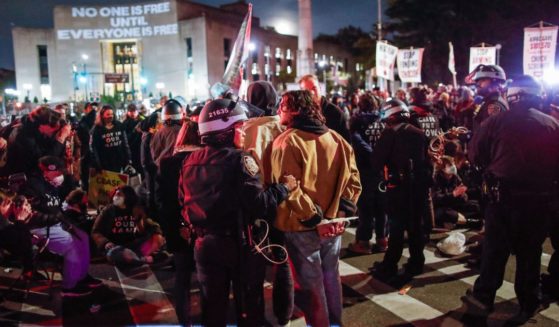Church Carvings in Centuries-Old Building to Be Replaced with Images of Feminist Figures
St. Mary’s Church is an anodyne enough name for a place of worship that it could be on Main Street in your hometown. In Beverley, a historic town in Yorkshire, England, it’s much more than that — unless you consider 901-year-old churches anodyne.
The church dates back to 1120, or about halfway through the medieval period. What is now the main church was built in 1520. Preservation of these kinds of landmarks is critical — although the preservationists don’t always get there in time.
As the Hull Daily Mail reported in May, the church’s carvings have been crumbling for some time. What’s worse, it’s impossible to figure out what the current carvings on the building even depict.
Enter Vicar Becky Lumley, who thinks she has the answer: New carvings of minority figures and feminist heroes.
“The green light was given by the Church of England’s Consistory Courts for the Grade 1 listed building to be given a BAME and achievements of women theme, taking into consideration the Church’s role in battling inequality,” the Hull Daily Mail reported on May 18.
BAME is sort of the U.K.’s version of the U.S. term BIPOC (black, indigenous or persons of color). In this case, it means “black, Asian or minority ethnic.” According to the BBC, the proposal also stated some of the women portrayed “must have local connections.”
“The contribution of women to humanity isn’t always properly recognized in the telling of history, and throughout history women’s voices have been silenced,” Lumley told the Hull Daily Mail.
“We take seriously the Church’s role in battling inequality and injustice. And so we hope that this project will help highlight the remarkable achievements of these women, and provide hope and inspiration for future generations.”
St. Mary’s Chancellor Peter Collier, who was the judge for the Consistory Court, said church officials had “made out the case for their proposal.”
In his consent, he noted that the carvings they would replace were eroded to the point where it was “impossible to tell what they were meant to be or whether there was any theme to them.”
“In my judgment it is entirely appropriate to celebrate these lives for their human achievement,” he added.
The featured women, according to the BBC, are Queen Elizabeth II; Mary Wollstonecraft, an 18th century writer and women’s rights activist; Mary Seacole, a nurse known for her heroism during the Crimean War; Amy Johnson, an early pilot; Hilda Lyon, an aeronautical engineer; Ada Lovelace, widely seen as the first computer programmer for her work with Charles Babbage’s difference engine in the 19th century; repeat Nobel Prize winner Marie Curie (physics and chemistry); and Helen Sharman, Britain’s first astronaut.
This is a fantastic list of people, but what does this have to do with history or Christianity? Wollstonecraft, for instance, was an influential feminist writer of her era and a brilliant woman, no doubt.
Unfortunately, she may best be remembered as the mother who died shortly after giving birth to her second child in 1797. That second child would grow up to become Mary Shelley and the author “Frankenstein.”
Wollstonecraft clearly has fans at St. Mary’s, but she also has fans at the Freedom from Religion Foundation, which salutes her in a brief biography as “an ardent rationalist and deist who adopted an agnostic point of view toward the end of her life.”
Whatever the merits of those points of view for Wollstonecraft’s countrymen, it’s fair to say they don’t exactly personify Christianity.
Of course, this is the Church of England — a desiccated-yet-woke state-run absurdity that’s desperately trying to remain within the ballpark of “Christian-ish” while still going through The Reckoning™.
“The announcement from St Mary’s comes just … after the Church of England published new guidance following the Black Lives Matter movement which urges churches and cathedrals to consider the history of their buildings and physical artifacts and how they could impact their congregations’ worship,” the Hull Daily Mail reported.
“It means many parishes have been forced to remove any artifacts linked to slavery and colonialism.”
As one problematic Britisher might have put it, there’s the rub.
Commissioning period-correct carvings — or even carvings of biblical figures, saints or religious figures — probably wasn’t going to make the nut once the Church of England put out that pronouncement about the Black Lives Matter movement. Thus, St. Mary’s, “one of the most beautiful parish churches in England,” the Hull Daily Mail notes, will be getting some feminist carvings. (Albeit with only one BAME carving — Mary Seacole, a Jamaican British nurse who was black.)
This isn’t the first time that the church’s adornment of the sacred has ended up with something closer to the profane. In 2020, according to the Hull Daily Mail, 14 carvings of characters from C.S. Lewis’ “The Chronicles of Narnia” were installed after they were blessed by the Bishop of Hull.
However, at least you could make the case “The Chronicles of Narnia” had decidedly biblical, Christian themes and Lewis was a renowned theologian and Christian apologist. Still, putting fictional characters from a children’s fantasy book series published in the 1950s into a church built 830 years prior is pretty clearly a case of St. Mary’s grasping for relevance.
Not only is this “feminist” move even more desperate relevance-grabbing, it’s completely untethered from history or Christianity in any real sense. Eternity or the past is swapped out for social justice. Oh, and a few good headlines.
Wait long enough, you get the feeling, and you might find a carving of all five Spice Girls at St. Mary’s.
Truth and Accuracy
We are committed to truth and accuracy in all of our journalism. Read our editorial standards.












